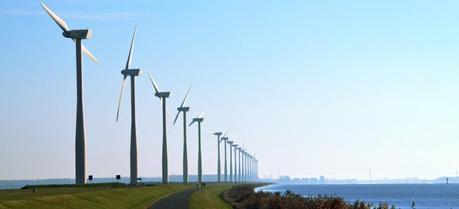 A wind farm in the Netherlands (Credit: Flickr @ Floris Oosterveld http://www.flickr.com/photos/floris-oosterveld/)
A wind farm in the Netherlands (Credit: Flickr @ Floris Oosterveld http://www.flickr.com/photos/floris-oosterveld/)
The four percent growth in renewable energy in the Netherlands, rising to 16% in 2023, as laid down in the recent Energy Agreement, makes electrical grid stability a pressing matter for the country. Urgent investment in electrical grid energy storage technologies is required to counter the impending instability caused by the increasing power surges of electricity from wind turbines and solar cells, according to the doctoral research by Stefan Nykamp at the University of Twente.
Looming blackouts, the shutting down of wind generators or dumping of (almost) free green electricity in neighboring countries because of the threat that the network will become overloaded. These are the current problems in Germany, which already generates a quarter of its energy from renewable sources. According to PhD student Stefan Nykamp, the Netherlands must learn from this and invest heavily in a stable network for a future with the generation of at least four times as much green electricity. Nykamp’s detailed case studies in Germany show that local storage in batteries is the best solution for this. The unattractive alternative involves extending the current network with an enormous number of new thick cables; an expensive investment of many billions that determines the situation for decades to come and requires old coal plants to remain on stand-by (contrary to the Energy Agreement). Local storage in batteries is a much more flexible system that prevents dangerous and costly instability on the network and permits the reduction of old plants.
The German problems with energy from the sun and wind are numerous. First of all, there is a threat that the German power grid will become overloaded if there is too much solar energy and if the winds are too strong. Germany regularly “dumps” excess green power in neighboring countries such as Netherlands, far below the market rate or even for ‘free’: a market disruptive phenomenon. Moreover, this is no longer a solution because the neighbouring countries themselves will also generate more green power. In addition, energy is regularly wasted due to the shutting down of wind generators to prevent the grid from overloading. As a country generates more electricity from sun and wind, there is an increased risk of blackouts: residential districts and industrial areas without power, with disastrous financial consequences. Germany already had a number of ‘near-blackouts’ this year and will also have to do something in the coming years now the country is heading towards 80% renewable energy by 2050 with all the additional fluctuations on the grid that this entails. “The Netherlands can and must learn from this”, says Nykamp who works at the largest German network operator Westnetz (RWE).
According to the research at the University of Twente, local storage of electrical energy is the inescapable solution. On windy and sunny days, the energy surplus can be stored temporarily in batteries near the wind generators and solar cells. The energy can then be consumed during the nights or following days (or be supplied to the main network) when it is cloudy and the wind has died down.
The alternative would be an updated infrastructure with many thousands of extra kilometers of thick cables to the highest voltage level in order to prevent overloading. According to Nykamp, some 380,000 kilometers of new cable networks (the distance from the Earth to the Moon) would be required in Germany alone in order to export the surplus green electricity to major centers or the neighboring countries. Cost: EUR 27 billion. In the Netherlands too, a multi-billion euro investment in cables would be much more expensive than the construction of additional energy storage in smart grids. On the basis of his detailed case studies, Nykamp expects that the tipping point at which the smart grids are the most cost-effective solution will certainly also be reached in the Netherlands.
Moreover, with the “infrastructure with new cables only” alternative, the existing generation capacity has to be kept in reserve. However, if you cannot reduce the number of gas and coal plants, but have to maintain them at minimum in standby mode, this also involves extra high costs. Nykamp: “I am convinced that storage in smart grids is the best solution for Germany and the Netherlands. But if we don’t invest in good time, we will be in real trouble.”
It is a bit odd that the scientist haven’t said anything about the pumped-storage hydroelectricity option. After all, pumped-storage hydroelectricity accounts for more than 99% of bulk storage capacity worldwide: around 127,000MW, according to the Electric Power Research Institute (EPRI). This figure can be significantly increased. In a recent report called “Assessment of the European potential for pumped hydropower energy storage” researchers from the Joint Research Center—a Directorate-General of the European Commission that provides independent scientific and technical advice to support a wide range of EU policies—say that Europe’s pumped hydropower storage can be increased tenfold, or even more, from current 2.5 TW·h up to 54 TW·h.
Other grid-scale energy storage options, like compressed air energy storage plants that draw power from the electric grid to power a large air compressor, which pushes pressurized air into an underground geologic storage structure, might also be viable.

